AK YOM
(700-725)
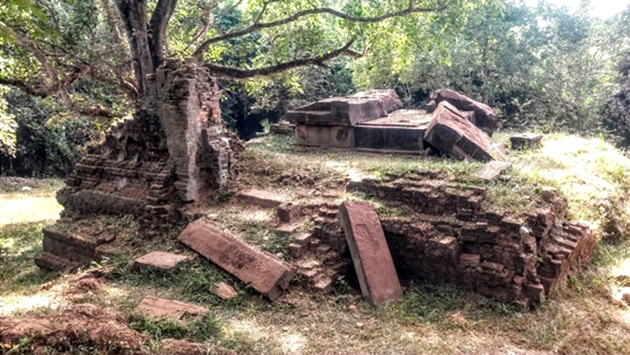
THE SITE FROM THE NORTH, AK YOM (700 - 725)
AK YOM
(700-725)

THE SITE FROM THE NORTH, AK YOM (700 - 725)
Ak Yom, despite its modest dimensions and ruined state, is arguably the oldest "temple mountain" in Asia, preceding even Borobudur (770-830) and Prambanan (850) in Java and the Ananda Temple (c.1100) at Bagan in Myanmar. (Ak Yom’s place in the development of the “temple mountain” at Angkor is discussed in section VII, “Aedicular Replication & Projection” of the introduction to this catalog.) The photographs in this asection are intended to supplement that discussion.
This view of the temple's remains is from the north on the levee of the West Baray whose construction buried the entire site of Ak Yom in the mid-11th Century. It shows the brick prasat or central shrine (3, on the site plan at right), the sanctuary or garbagriha (2) within it, as well as the narrow, upper, 3rd terrace or plinth (5) on which it sits. Also visible at its center is the sandstone altar with an opening for the now-lost Shiva linga and, to its right, a shaft leading to a subterranean chamber beneath the cella found to contain auspicious items, as prescribed in the Vastu Shastra, for a temple's "ground-breaking." The shrine would have been approached from the eastern entrance 4) so the north portal may have been "blind," i.e., walled with brick.
Although only the northeast corner of the shrine remains, it exhibits the projections and moldings characteristic of the standard Khmer prasat; little appears to have changed since its emergence at Sambor Prei Kuk (600-650). These include: a) the square corners (karna rathas, 1) of the shrine sometimes with a recessed wall framed by pilasters, which may contain a niche or brick bas relief, e.g., a "flying palace,” b) the barely-emerged porch (anu rathas, 2 and 5,)and c) the more pronounced jambs (raha rathas, 3 and 4), which would have contained between them the colonettes found scattered at the site and the missing lintel and pediment. Thus, the shrine has five projections and is, technically, pancharatha like the plinth or upper terrace (5.)
The outer or 3rd enclosure (9) has yet to be excavated; pictured here is the 2nd enclosure or 2nd terrace (6) and the upper terrace or plinth (5). In the foreground is the foundation of the easternmost of the two small, facing shrines (not the corner of the 2nd enclosure wall.) As shown in this photograph, the temple was built on an artificial mound; the second terrace (6), while relatively wide, had a pronounced slope continued on the upper terrace or pancharatha plinth (5) contributing to the temple's symbolic meaning as a replica of Mt. Meru. The stairs (at center) would have been extended by steps up the sides of the plinth to the shrine's portal. Ak Yom was the first, single Khmer prasat or temple to have three enclosures, as well as, the first where those enclosures were interpreted as the rising terraces of a "temple mountain."
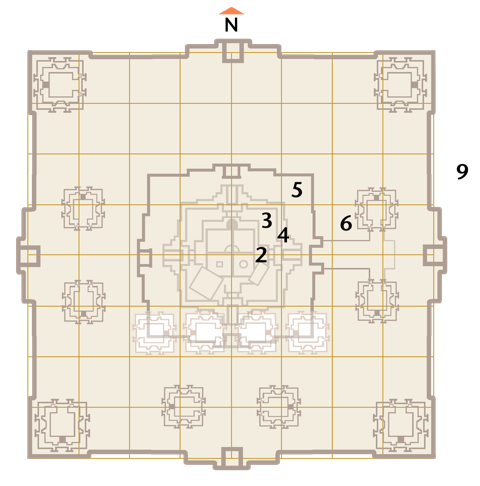
SITE PLAN, AK YOM (700-725)
PRE-ANGKORIAN
SCULPTURE
(650-800)
The period between the end of the "First Khmer Empire" around 650 and its re-founding when Jayavarman II (790-835) proclaimed himself chakravartin in 802, has generally been regarded as a period of decline. It is thought the Khmer may have been pushed from Chenla to the northwest by a Srivijayan incursion up the lower reaches of the Mekong; Ak Yom's location west of Angkor, Hariharalaya (Roluos) and the Kulen Plateau may lend some credence to this theory. Local Khmer nobles used the lack of a central authority to establish independent polities, not exactly city states since they appear to have migrated frequently. Artistic quality did not, however,suffer as a result of lost political power and consequent instability; Khmer lintels and sculpture developed through two distinct periods Prei Kmeng (650-700) and Kompong Preah (700-800), named after sites where exemplars of these styles were found. These centuries saw some of the finest carving in Khmer art, as well as the invention of the floral garland as the central motif of future Khmer lintels.
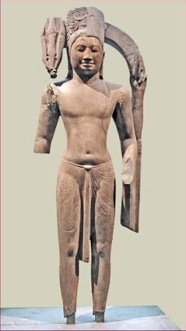
HARIHARA,
ASRAM MAHA ROSEI,
PREI KRABAS, TAKEO,
MUSEE GUIMET (c.650)
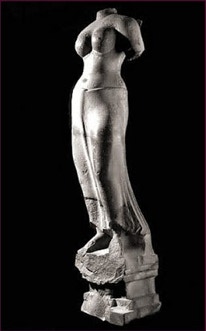
DURGA MAHISHASURAMARDINI,
SAMBOR PREI KUK,
NATIONAL MUSEUM, PHNOM PENH (c.650)
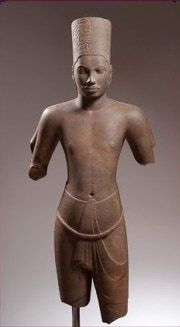
HARIHARA, KOMPONG CHAM, KIMBELL ART MUSEUM, FORT WORTH (775-800)
Early Khmer sculptors attached standing statues to supporting arches, a convention abandoned with the development of more stable forms. Harihara is a hybrid of two of the Hindu Trimurti, Vishnu (Hari, proper left) and Shiva (Hara, proper right), reconciling the paradox of destruction (dissolution or transformation) and preservation (form) at the heart of Hinduism's cyclical cosmology. (The third member of this trinity, Brahma, is less frequently depicted.) The two halves of the statue are identical except for the head and hair; Shiva is depicted with the matted locks of an ascetic, a result of the holy waters of the Ganges flowing through them down to Earth; Vishnu wears the plaited headdress or crown of kingship, echoing the sanctity of the Khmer feudal order. The original statue would have had two of the four distinctive attributes of each deity in their hands but traces of only two remain: Vishnu's discus or chakra, a weapon, as well as, symbol of the "wheel of dharma" or divine law, binding the universe together in his role as the "preserver" and Shiva's trishula or trident, missing its staff. This combination of the two gods was especially popular in the Pre- and Early Angkorian period; the first capital of the "Second Khmer Empire" was, in fact, named Hariharalaya (the present-day village of Roluos.) The combination of the two deities on an equal footing reflects the Khmer's preference for merging rather than opposing different gods and religions. As an "imported religion," they may have viewed the Hindu Trimurti as different aspects of a single divinity. In contrast, in India bahkti – personal devotion to a particular deity – increasingly became the dominant practice in that religion.
Sambor Prei Kuk was the site of the first ceremonial center of the earlier Khmer Empire, Isnanapura (or Ishnanapura) in Central Cambodia. Durga, the "Buffalo Demon Killer," is a fierce, aspect of Shakti, representing the "great goddess" as well as "female energy" and fertility, perhaps originating in a pre-Vedic substrate. She was created by the gods because only she, not even one of the Trimurti, could kill the "buffalo monster" who was devastating the Earth; she is often associated with Parvati, Shiva's consort. This figure is among the more sensual and graceful in Khmer sculpture, which tends to abjure the eroticism of Indian art in favor of more hieratic representations of divinity or power, rather than the emotions or character specific to that deity.
In this later representation of Harihara, dating from just before the re-founding of the Khmer empire in 802, the hybrid deity is portrayed more naturalistically. His expression is not set in the "archaic smile" of the imperturbable immortals but concentrated on inward meditation, the source of his spiritual power. Shiva's hair here is arranged in a wave pattern like the River Ganges which ran through it and half of his identifying, third eye is visible on the forehead. Vishnu, in contrast, wears a sovereign's crown, like a bishop's miter. Both are dressed in the characteristic Khmer kampot; its differing forms are among the more reliable markers of a statue's date, although the way in which it was tied remains disputed.
39